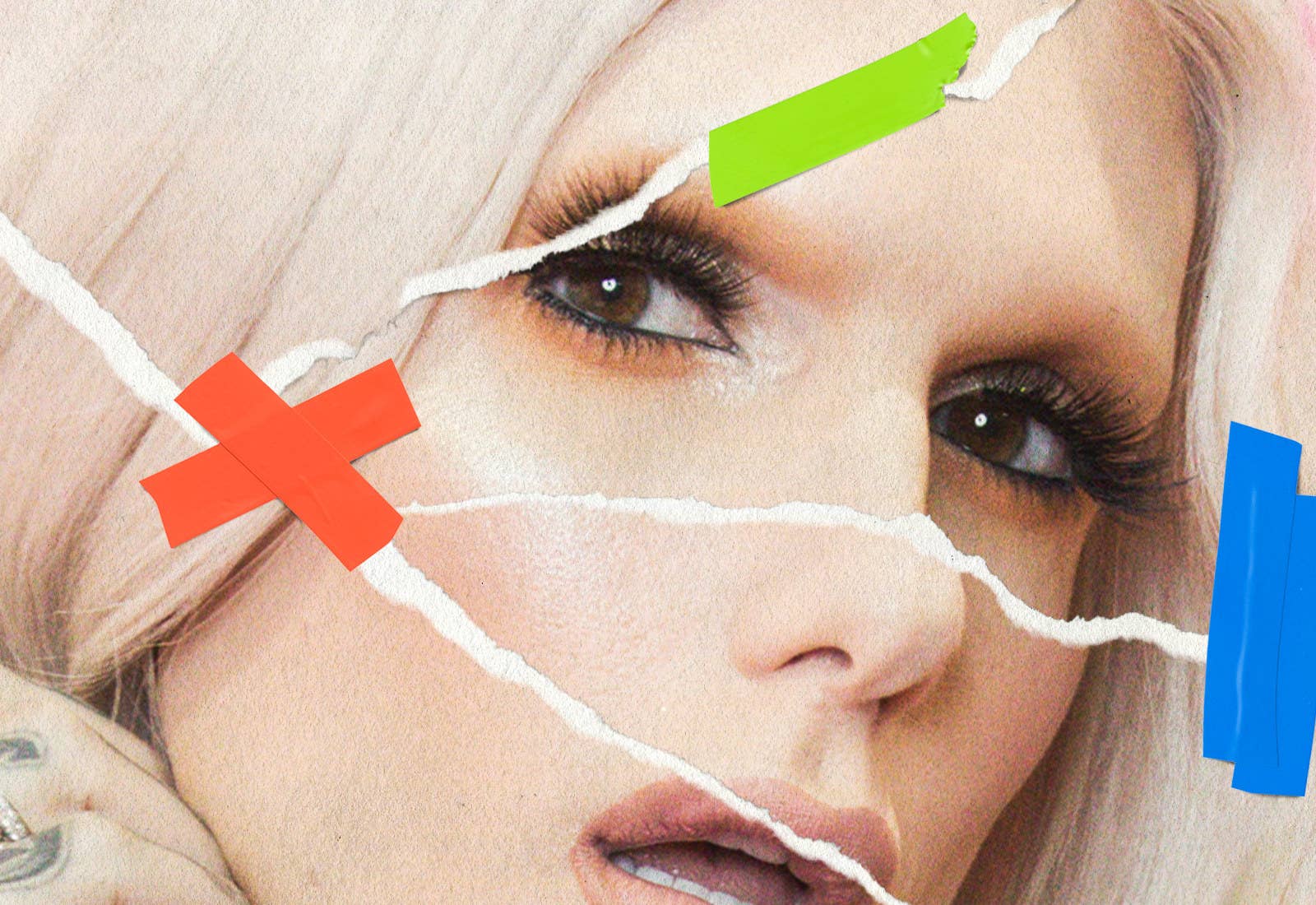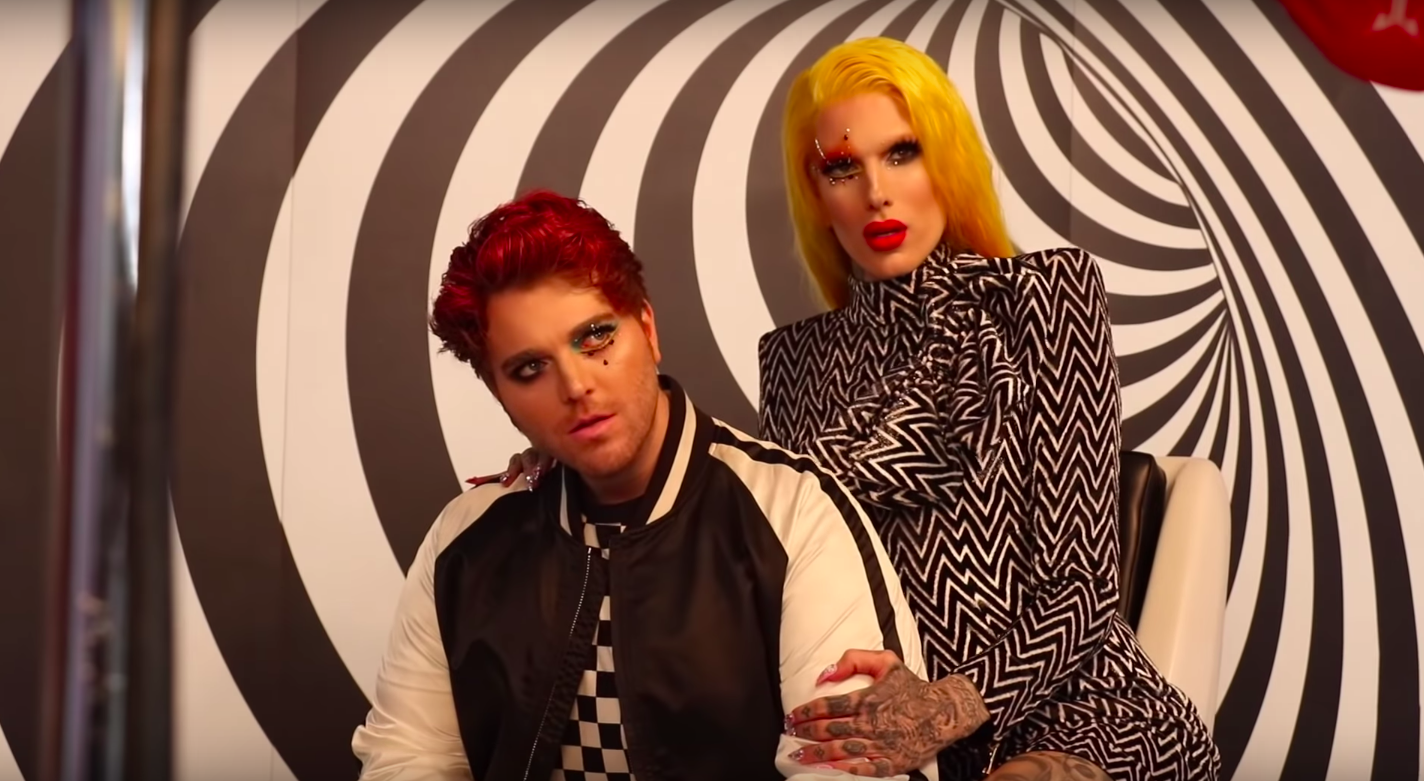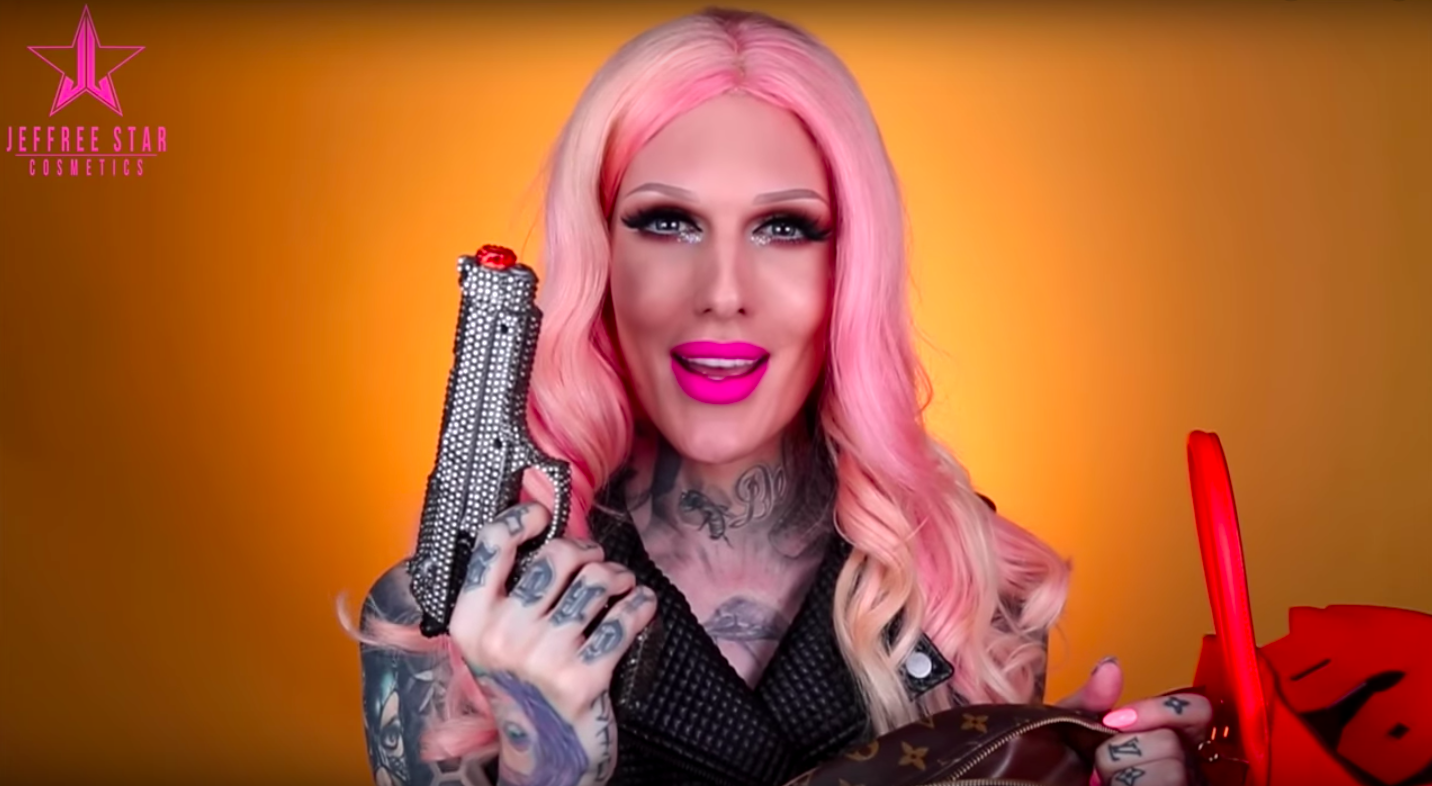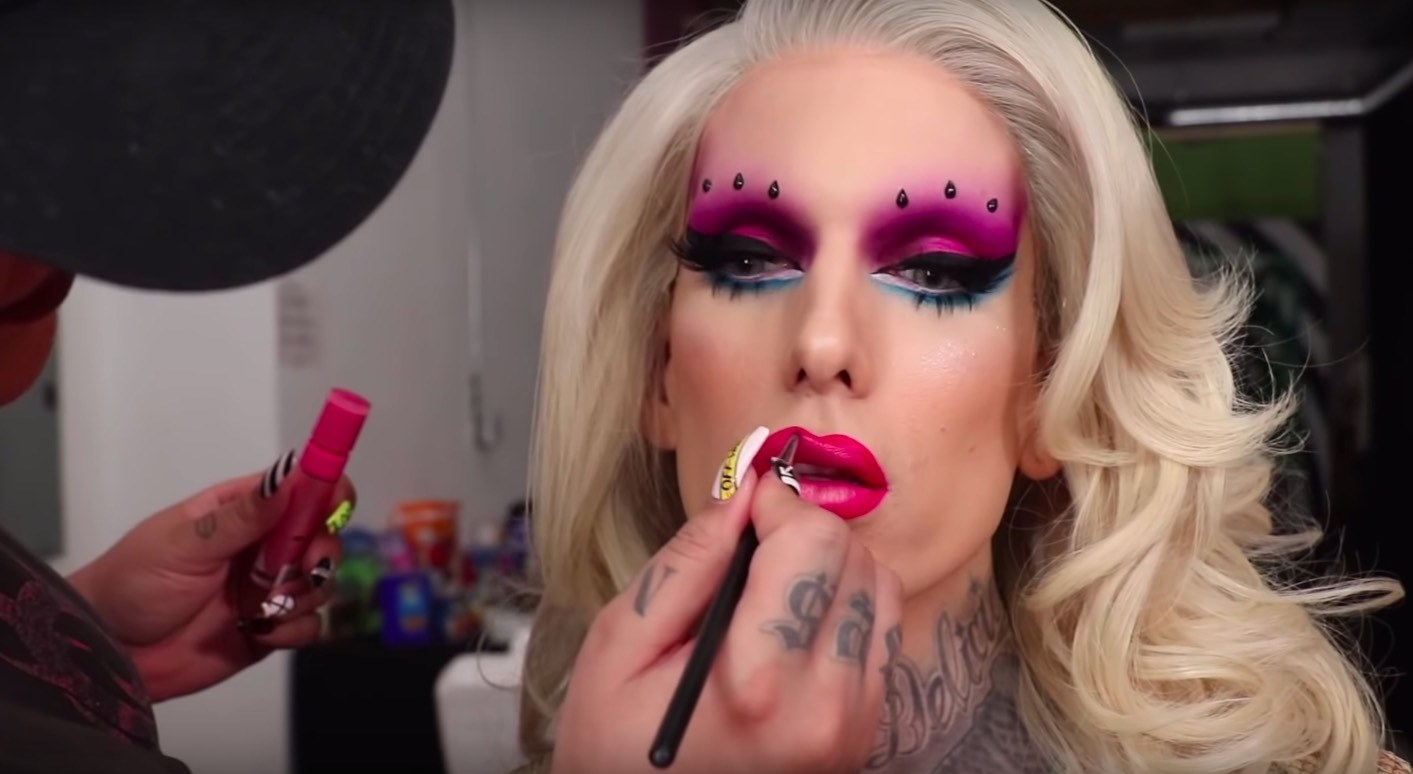
The life cycle of a makeup YouTuber is pretty rote at this point. You start small, reviewing products and making how-to videos. Eventually you invest in a ring light, make a little money, and start buying Anastasia Beverly Hills brow powder so you stop looking like Groucho Marx. You get in on challenge videos, doing your makeup in the back of a car, for example, or while blindfolded or with drugstore products only. You make more money, start selling your own merchandise or, if you’re lucky, do a collaboration (you call it a “collab”) with Morphe for brushes or palettes or setting powders. Then you say something offensive — maybe it was a few years ago and you forgot you ever said it, maybe it’s some bygone tweet that is probably, definitely racist — and then you have to make a video apologizing. As proof that you’re being sincere, you demonetize the video and film it without makeup or filters. Everyone is mad at you. You wait it out. Then you get back to work.
Jeffree Star, a 34-year-old makeup artist, entrepreneur, and prolific YouTuber with 16.6 million subscribers, must know this routine by heart. Once a musician and club bunny running around LA in the early aughts, he launched Jeffree Star Cosmetics in 2014 and is now successful, controversial, and rich. In 2018, Star made $18 million from his YouTube channel alone, making him one of the top five earners on YouTube, in addition to the estimated $100 million worth of product sold through his cosmetics line.
Star has also had to apologize — a lot. Like in 2017, when racist videos he’d made more than a decade prior began circulating (“I apologize deep down to the core of my fucking being,” he said at the time), or when footage of him following women and screaming the n-word at them resurfaced. There were other controversies, too — the video of him harassing a Warped Tour attendee in 2009 (which he never addressed), or the time his former best friend and cosmetics industry competitor Kat Von D accused him of shady business practices in 2016 (which he denied) — but honestly, who can even keep up?
For the entirety of his YouTube career, Star has gotten pulled into, or involved himself in, just about every major makeup YouTube drama. When James Charles and Tati Westbrook got into a public feud, Star took it upon himself to pick sides. He successfully hassled Kylie Jenner until she fixed her useless and frayed liquid lipstick wands. Star is the reason for the Gabriel Zamora/Manny MUA/Nikita Dragun/Laura Lee catastrophe, where they were exposed for their own histories of racist comments. He even got involved in a fight with NikkieTutorials after she gave Tarte’s new concealer a good review, despite its limited shade range. Somehow, all roads in the YouTube beauty world seem to lead back to Star.
Somehow, all roads in the YouTube beauty world seem to lead back to Star.
In early October, fellow YouTuber Shane Dawson (who has 23.1 million subscribers) released the first episode of a six-part (so far) series with Star. Dawson, 31, is a longtime presence on the platform who first made a name for himself with common (if sometimes worrying) YouTube fare — conspiracy videos, food videos, challenges — but has since pivoted, in the last few years, to filming documentaries about other YouTubers. This particular series ended up being a rather shrewd marketing plan: Dawson and Star used The Beautiful World of Jeffree Star as an opportunity to promote a new “Conspiracy Collection” makeup collaboration to their vast combined audience.
The release, which sold out in less than an hour and crashed Shopify when it launched on Nov. 1, included clothes, backpacks, makeup bags, eyeshadow palettes, lipsticks, and a “Shane Glossin’” clear gloss. And the collaboration has been profitable for both stars in more ways than one. While Dawson’s video series purported to be an inside look at the beauty industry and what it takes to release a makeup line, it was also a clever means of ongoing reputation rehab for two YouTube personalities who have been dogged by controversies for years.
No one wants to keep talking about “cancel culture” less than me, but it is striking how many chances Star has gotten. He’s been accused of racism, of selling poorly made makeup (an outright sin in the beauty community), of being a manipulative jerk to his friends and enemies alike. Sometimes he’s sorry and other times he’s not; either way, he still has one of the most profitable and best-known channels on YouTube. (Contacted through a representative, Star did not reply to a request for comment about the various controversies and allegations mentioned in this piece.)
There was a time, maybe when allegations of Star’s racism first came out, when he needed to apologize for offending people or risk sinking back into obscurity. YouTubers, unlike other entertainers or creators, are almost entirely beholden to their audiences’ whims. (James Charles, who lost more than 3 million subscribers in the immediate aftermath of Tati Westbrook openly scolding him on YouTube, had to respond if he wanted to bounce back.) At this point, Star probably doesn’t need to make any amends at all to retain his audience. But now he seems to be in search of something more than attention — a deeper level of image therapy. Which is where Dawson comes in.
Dawson had already made one series of video interviews with Star in 2018, The Secret World of Jeffree Star, which shows a more vulnerable side of him; in one episode, Star talks about his many feuds with former friends in the world of beauty YouTube. “I only loved and cared about all these people … and I’m still the fucking bad guy,” he tells Dawson. “As time goes on, I don’t feel the need to prove as much, but it’s hard, you know? I’m just one person that’s had a crazy, fucked-up past and I’m just trying to be a better me.”
In their latest collaboration, the “better” Jeffree Star is deliberately front and center. Dawson’s trailer for the new series teased YouTuber drama, and more of what Star does best: settling scores and getting into the dirt. In reality, the series turned out to be almost boring, since it was mostly about the two YouTube stars marveling at their own business acumen and crying over their shared success. And yet, tens of millions of people — myself included — watched it. Star clearly hasn’t been canceled. But is he worth rooting for?

At 34, Star has already lived a few lives. He was born Jeffrey Steininger and grew up in Orange County, raised largely by his single mother after his father killed himself when Star was a child. He was gay and femme and interested in makeup, a combination that led to some pretty ruthless bullying and harassment.
“When I tattooed my whole body, a lot of it was hiding emotions and pain,” Star told Dawson in 2018. “My whole body is covered in scars because I didn’t know how to express my feelings when I was younger.”
After Star graduated from high school, he moved to LA and supported himself by modeling and doing makeup. He got into clubs with a fake ID and quickly made himself a minor fixture in the LA party circuit. (That said, Star still claims he’s never consumed any alcohol or done any drugs beyond weed, of which he smokes a great deal.)
It was in the late aughts that Star joined Myspace and started making music. Today, Star’s face is kind of timeless, androgynous, and otherworldly; it doesn’t seem to respond to aging or the sun or stress, thanks to a rigid skincare regimen and some plastic surgery tune-ups. Back then, Star’s look was even more gender-fucking than it is now. He had sharp, thin pink eyebrows, a shock of bright pink hair, and heavy blush on his cheeks. One of his Myspace photos was of him putting his finger down his throat and vomiting up pink fluid. Star was Myspace personified, a personality that likely would not have survived beyond that particular ecosystem without some significant adjustments. (Remember Tila Tequila? Yeeeeikes.)
In 2009, Star released Beauty Killer, his one and only album, which includes the songs “Louis Vuitton Body Bag,” “Love Rhymes With Fuck You,” “Fame & Riches, Rehab Bitches,” and “Lollipop Luxury” featuring Nicki Minaj. It’s absolutely terrible, one of the most 2000s-esque relics you can find on Spotify. The album cover was shot by Kat Von D, Star’s then–longtime friend, who would also tattoo much of Star’s body. Star ended up at Warped Tour in 2008 and 2009.
In 2010, Star signed with Akon’s label; the music producer called Star a male version of Lady Gaga. “He has that curiosity that’s going to make people be like, ‘Who the hell is that? What the fuck is that?’” Akon said in 2011. The relationship didn’t last long; in his first series with Dawson, Star talks about how depressed he was after his career didn’t take off.

“Those are dark times for me. Very depressing,” he tells Dawson while old photos of him with Miley Cyrus, Kesha, and Demi Lovato scroll by. “I quit as a working makeup artist to do music. I invested so much into it, and all my money and all my time.” He ended up going broke trying to make it as a singer. That’s when Star pivoted to YouTube.
Star’s early YouTube videos were mostly makeup tutorials and some videos with RuPaul’s Drag Race friends like Laganja Estranja or Alyssa Edwards. Star’s look mellowed out around this time: The big pink wig was gone, traded in for a short, bright pixie cut; while the brows were still pink, they were a little more human. And it wasn’t just the makeup; Star’s lips were new, his teeth had all been replaced with pearly white caps, and he got a new “vanity” forehead tattoo.
Star’s videos from back then are markedly different than they are now. There was less discussion about his dick and where it’s going, and he didn’t start each video by waving a mirror and saying “Hi, how are ya?” as is his current routine. Most uploads were just straightforward how-to videos. There was less discussion about his wealth and designer goods. But at the time, there weren’t that many men doing makeup on YouTube, especially for daily wear, beyond drag queens and impersonators. Even fewer were getting into the industry itself, making and promoting their own lines of makeup. In that sense, Star was revolutionary, a representative for a class of people rarely recognized in makeup.
Within a few years, Star had launched his own cosmetics line with just a few lipsticks — all of which sold out as soon as they became available in 2014 — and he’d become a trusted voice on YouTube for being radically, ruthlessly honest about what makeup was actually worth the hype. He told viewers when a Kardashian-sold product was actually nonsense, called out Tarte for a pitiful foundation shade range, tested wildly expensive products versus their drugstore counterparts (and often sided with the drugstore dupe, despite his own affection for the finer things), and generally took no shit. When Urban Decay started selling a “sex-proof” mascara, Star wisely tested it out by giving his boyfriend oral sex off-camera, returning with makeup running down his cheeks. (Nine million views.) He also brought his viewers into the doctor’s office with him to watch his cosmetic surgeries, at a time when YouTubers and other influencers were a lot less eager to admit to getting work done.
He was loud and bombastic and aggressive and often insensitive. Star inadvertently helped other YouTubers establish their own cottage industry of “tea spill” videos about his antics, like this one where Star snapped at a fan on Twitter for promoting his own makeup work. (Star is perhaps best known on Twitter for blocking and muting anyone who criticizes him.) In a way, he simultaneously made himself a target — by documenting so many of his own offenses, by starting so much shit — while also ensuring his own invincibility. The basic currency of Star’s world was brutal honesty and calling others out. How could anyone else ever hope to “expose” someone who had already so thoroughly exposed himself?

Undoubtedly, Star has had a rough life. As a man in the makeup industry, never mind the music and modeling industries, he faced a lot of anti-gay and anti-femme-discrimination, violence, harassment, and unwarranted hatred. In one of his videos, where he shows viewers what’s in his Birkin, he pulls out a pink drill, a pink comb that’s actually a knife, a pink mace gun, and a Swarovski crystal–encrusted fake handgun. “From far away, it does look dangerous and some people won’t call me ‘faggot’ ever again,” he says.
But no amount of personal difficulties can excuse cruelty. In 2018, fellow makeup YouTuber Jackie Aina said on Twitter that she wouldn’t be able to overlook Star’s offensive actions. “I have not and will not excuse his blatantly racist behavior — not his past references to me in derogatory terms, his continued use of the N word, nor his efforts to eliminate spaces and opportunities for people of color,” she wrote. “Let’s stop making exceptions for people just because we like the way they blend eyeshadow.” (Star never publicly responded to Aina.)
This came after years of allegations against Star for racist and insensitive comments. In 2016 and 2017, an old Myspace skit in which Star says he wants to throw battery acid on a black woman to lighten her skin tone started to circulate. Star’s former hairstylist came forward with text messages that allegedly show Star using the n-word and calling Aina a “gorilla.” In 2017, Desus & Mero gave us an entire compilation of at least a few of the times Star has said the n-word on camera.
That same year, Star made a video titled “RACISM.” Wearing a tasteful V-neck sweater and soft makeup, he apologized for his past and offered more context. “In these videos, I say some really disgusting, vile, nasty, and embarrassing things,” he says. “I don’t know who that person was. I know who I am today. The person that said those horrible, vile things, that person was depressed, that person was just angry at the world, that person felt that they were not accepted, that person was seeking attention. I loved fighting anger with anger. I didn’t know any better.”
But it wasn’t just the videos. Star’s old tweets are a graveyard of grotesque threats and insults. “My revenge on you will not kill you,” he wrote in 2011. “It will make you wanna kill yourself.” In 2010 and 2011, he made a lot of references to getting raped and enjoying it. And while he would later criticize Charles for allegedly hitting on straight boys, his own tweets suggest he attempted some of the very same.
How could anyone else ever hope to “expose” someone who had already so thoroughly exposed himself?
In 2016, Star’s former best friend Von D announced in a Facebook post and a YouTube video that she’d decided to “disassociate [her]self completely” from Star. “After years of making excuses for, and rationalizing Jeffree’s inappropriate behavior (including, promoting drug use, racism, and bullying) I can no longer hold my tongue,” she wrote on Facebook. Her chief complaint in the video was that Star hadn’t paid the man who helped design his company logo. She lamented how much Star had changed since they first met, calling him “this big, attention-seeking, fame-desiring, money-driven monster that I want no part in.” (Star ended up making his own video in response, in which he refutes all of her claims.)
Then there are all the fights Star gets into that don’t have a single thing to do with him. Star has fought with nearly every makeup influencer or mogul in the country, from Kylie Jenner (he hated her $360 brush set), Jordyn Woods (claimed he knew she was messing around with Tristan Thompson for a while), and the owner of Too Faced (who allegedly underpaid another vlogger). He’s cycled through a lot of internet-famous friends in the YouTube beauty world, including Manny MUA, Nikita Dragun, Jaclyn Hill, Laura Lee, and James Charles. All of those relationships have combusted dramatically and publicly, usually ending in tear-streaked, accusatory breakup videos.
Star is your quintessential pot-stirrer, even if he still thinks of himself as a brave truth-teller. It makes for good watching — there’s a reason why “Jeffree Star snapchat rant” yields a whole lot of results on YouTube. And his personal brand has obviously been compelling to a lot of people. “I always romanticized this aspect of Jeffree,” Von D said in her 2016 video. “The fact that he was this outsider, he was different, and giving his followers a sense of belonging in a world where people tend to reject something so different.”
But Star seems to want to be all things to all people. He must know, on some level, that his fame is largely a product of his aggressive behavior, and dramatically changing his approach or cleaning up his act would mean losing some part of his audience. “Me being nice or positive is not what people want to hear, which sucks,” he told Cosmopolitan in 2017. But he also, at least lately, has been positioning himself as a sensitive, thoughtful leader in his chosen industry. He wants, for once, to be the good guy.

After years of wild success, Star has undeniably become less of an angry outsider. Now he tends to favor soft tracksuits, his ash-blond hair cut in a bob and sometimes curled at the bottom. He’s often wearing highlighter and a wearable lip color, as opposed to the bright yellows and blues his makeup line sells. The look is still dramatic and otherworldly — he sometimes doesn’t wear any eyebrows at all — but it’s more approachable. On Instagram, when he cries tears of joy (successful makeup launch) or pain (two dead dogs), sometimes he doesn’t wear makeup at all. Now that’s sincerity!
Dawson, the latest in a long line of Star’s “best friends,” has also helped reinforce the idea of a new, softer Star. The Secret World of Jeffree Star indicated an attempt to humble himself, or at least appear more honest about his past than he has been. In these videos, he’s still wealthy and still talking about it, but he’s no longer opting for dramatic moves like cutting designer bags in half with a knife heated to 1,000 degrees. Star shows off his home and his company and explains how he got so rich. He also addresses the allegations of racism, admitting to Dawson that his past comments were horrible, but offering a quasi-defense that when he used the n-word, he didn’t say it to a person of color. (This is not a great defense.)
Some of Star’s defenses ring hollow, but he comes across as sincere and vulnerable when he’s able to connect his actions to his own trauma. “Yeah, I’m a damaged person, 100%. I would never not admit that,” he says. Later he says, “I’m scared to ever talk about this stuff,” discussing his history of cutting and his father’s suicide. “I don’t want my pain to be made fun of so I keep it here, where it’s safe.”
Star and Dawson are, in some ways, unlikely business partners. Star’s whole shtick is glamour, wealth, cars, and stuff. He built a closet in his house that’s protected by a pink vault door. Dawson’s brand, meanwhile, is utterly approachable. He talks about his struggles with mental health, takes his medication on camera so frequently that one of the colors in his new palette is called “My Pills,” and discusses his weight loss (and gain). In the 2018 series about Star, he also documents some of his personal life, including proposing to his boyfriend.
It’s not clear how much Dawson had to do with the new makeup line “collaboration” on the back end. It seems as if his involvement didn’t really go beyond suggesting a few colors and shade names — Star’s employees and his production plant handled the rest. Shane’s videographer and editor came up with the design for the packaging. (The makeup is...fine.)
There’s nothing revolutionary about the products; the most remarkable thing about the makeup line is the ingenious marketing strategy used to sell it.
There’s nothing revolutionary about the products; the most remarkable thing about the makeup line is the ingenious marketing strategy used to sell it through what amounts to a miniseries’ worth of free advertising on YouTube. The October series was true blockbuster content: The view counts for each hourlong video range from 14 million to 25 million. (The Game of Thrones series finale, for comparison, broke records by bringing in 19.3 million viewers.) And yet, to anyone who isn’t already immersed in the cult of personality around Star or Dawson, it’s very unclear why the videos would be entertaining.
At least in Dawson and Star’s 2018 series, they actually talked about substantive things. In this second one, they mostly cry a lot about how great their clear lip gloss is going to be. There is no dirt on other YouTubers, and almost no drama; instead, you get a lot of vagaries about how toxic the makeup world is, details about what it takes to release a new product, and shots of Dawson watching his makeup get assembled and looking humbled. Dawson and Star act like they’re turning the makeup industry on its head by releasing a few palettes and some lipstick shades that seem to be intentionally hideous.
The wildest part is that they might be right. The Conspiracy collection has been a resounding, almost preposterous success. According to Star, they’ve sold 1.1 million eyeshadow palettes since they launched on Nov. 1, and they’re completely sold out at the moment. Shane Dawson merchandise, also sold through Star’s company, Killer Merch, is largely sold out as well; if you want an $80 pig backpack or a hoodie that acts as an ode to the guy who helped film and edit the series (very specific) then you’re out of luck for now.
In all likelihood, the collection would’ve been plenty successful without a miniseries about how they made it. What was more important is that Star and Dawson reframed how the audience should think about them and their success. The series shrewdly includes Star’s personal ups and downs, like when his dog died or when his factory was robbed of millions of dollars worth of merchandise. The moral of the story is that they’re hard workers, they’ve had some bad luck lately, they deserve it. Comments on the YouTube videos express exactly that: Dawson and Star’s audience is emotionally invested; they want to feel like they’re a part of these powerful YouTubers’ success.
Most YouTube creators, and specifically makeup YouTubers, can’t get away with being a jerk, except for a select few: your Logan Pauls and your PewDiePies. Like all influencers, they need to exhibit some shred of humanity or relatability to keep viewers coming back. At this point, it seems as though Star actually has joined the select rank of un-cancelable YouTubers who could weather any storm. That doesn’t mean, however, that Star will stop insisting that he’s actually the hero of this story. After all, no one wants to root for a villain. ●
